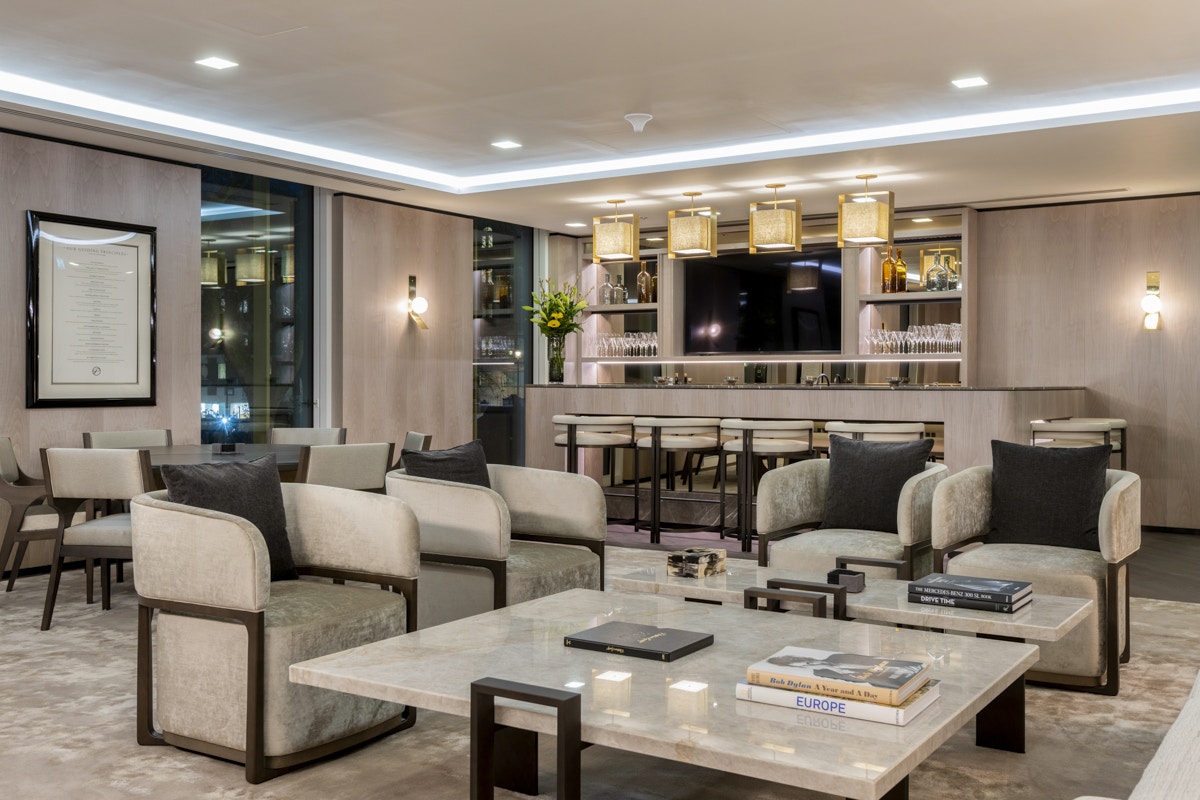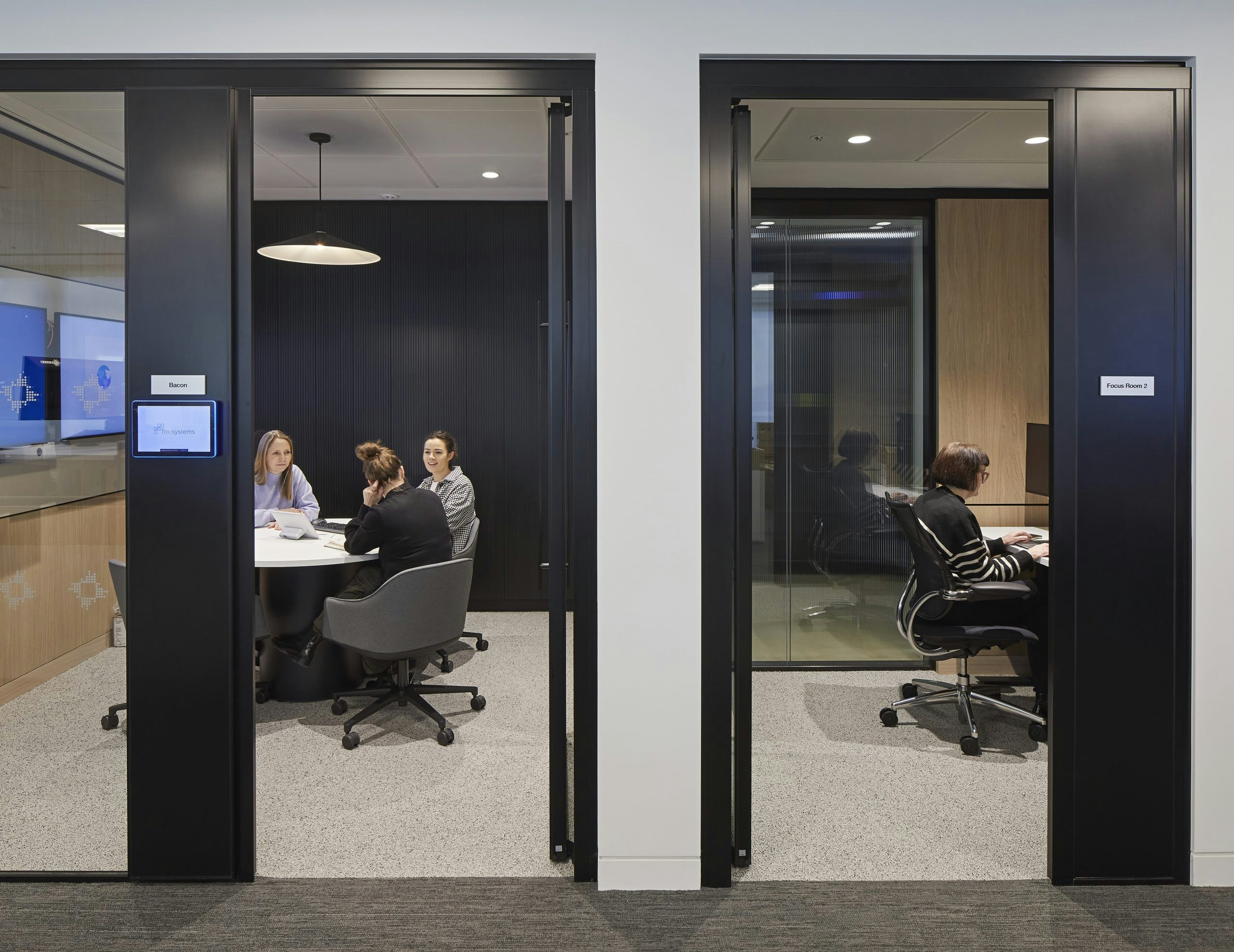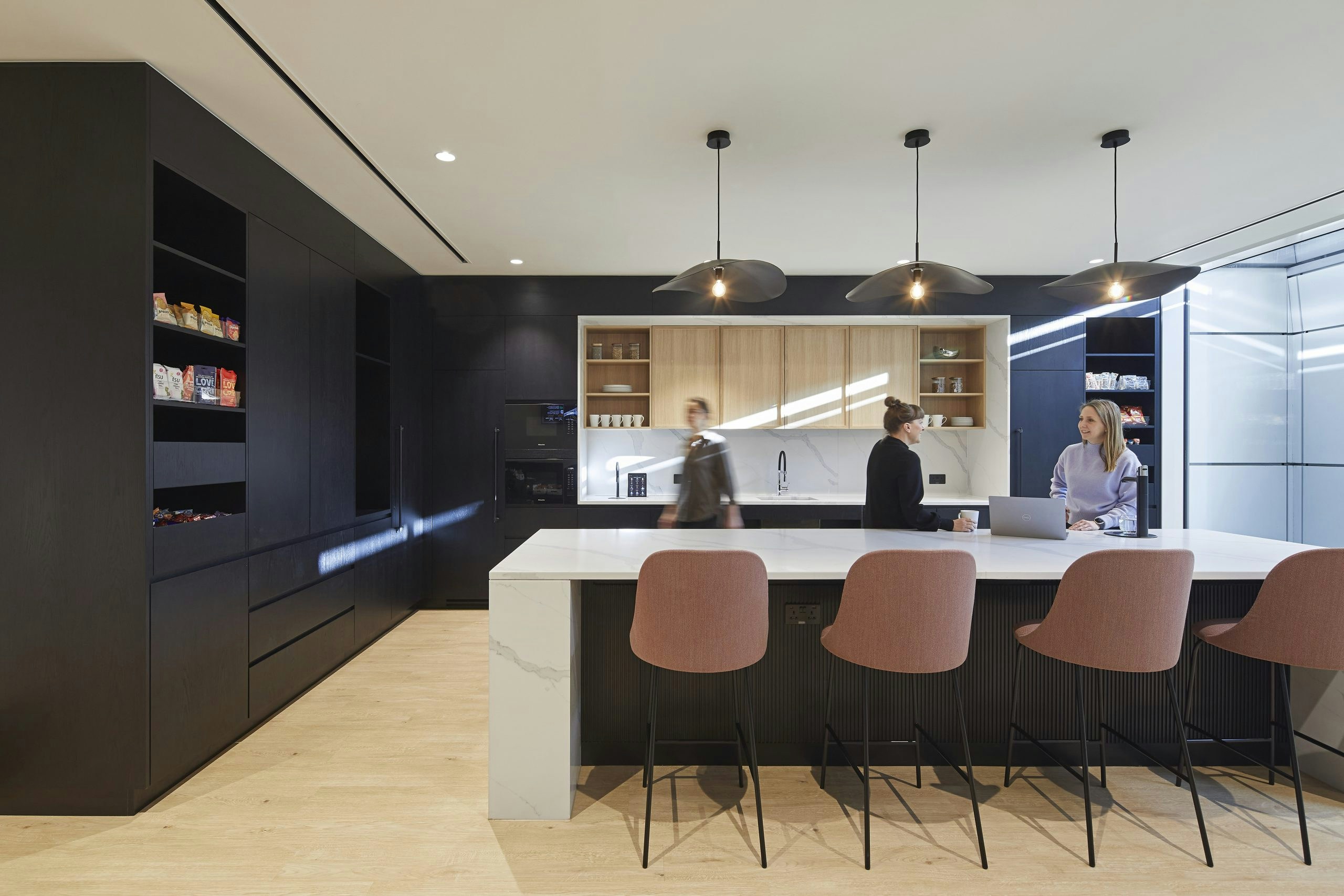With significant experience in the distinct requirements of the financial services industry, we’ve been specialising in providing office design, fit-out and furniture solutions for financial services firms for the past 20 years. In particular, we’ve built expertise in fit outs for high-end financial firms such as private equity firms, boutique banks, and asset management companies, where the quality of furniture and finishes is crucial. Without question, a well-designed office can positively impact employee productivity, health, and well-being, and contribute to the overall success of a company. Additionally, office design now plays a significant role in promoting Environmental, Social, and Governance (ESG) practices, which are increasingly important to investors.
This article looks at the key features in planning an office fit out, as well as examples of projects that we’ve completed in the financial services and related sectors; among them Rolls Royce Partners Finance, PTJ, LLCP and Victory Hill. The aim is to provide some guidance and support for companies planning office moves, refurbishments, or just gathering information for the future.
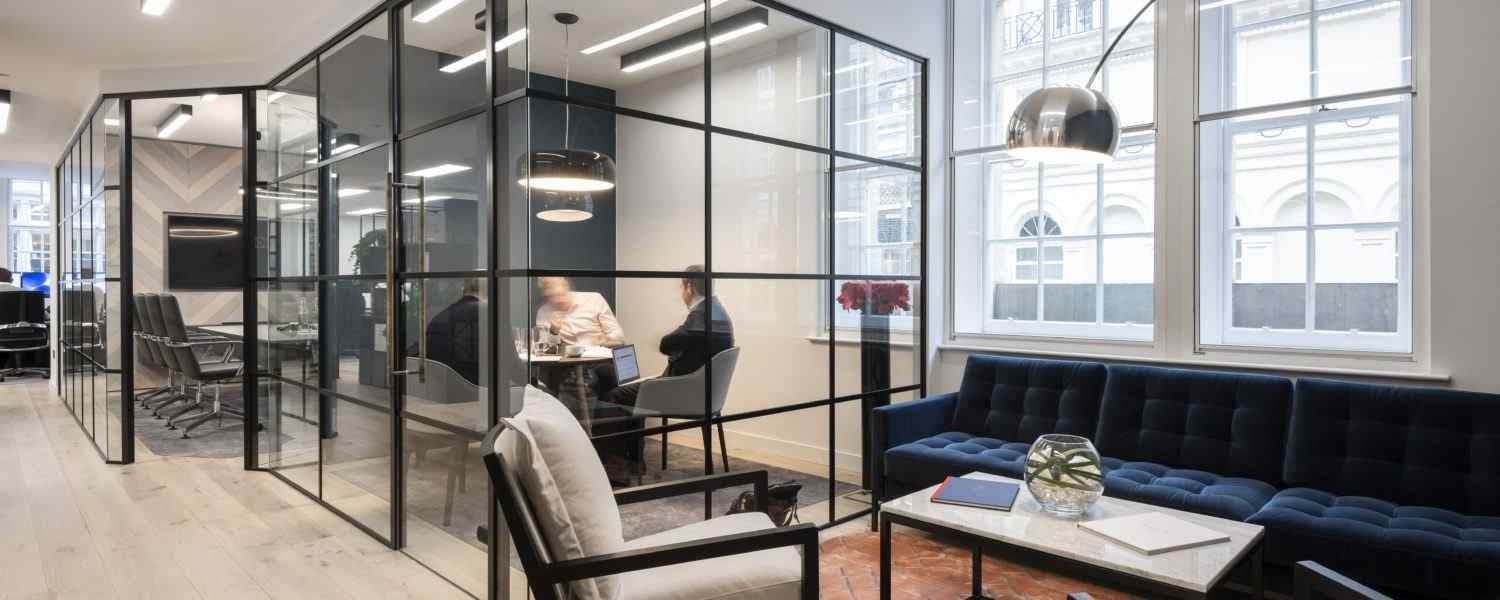
Distinguishing Features of Office Design in the Financial Services Sector
Financial service firms tend to have a few distinct factors in office design; typically (1) higher-end materials and finishes, (2) client-facing areas – barista areas, wine, touch-down areas, bar and restaurant areas, (3) privacy and confidentiality – the inclusion of private offices and meeting rooms, soundproofing, and other features (4) tech and screens – (5) ESG and Sustainability BREEAM. That said, most business sectors are seeking similar outcomes; collaborative work areas, agile/hybrid working, quiet areas, meeting spaces, and workstations.
Companies that prioritise ESG in their office design can create a more sustainable and responsible workplace, which can enhance their reputation and appeal to investors who are increasingly focused on sustainability. Investing in sustainable office design and technologies can also help financial services organisations reduce operating costs and improve efficiency, making them more attractive to investors. It is therefore essential for companies to consider ESG and investment implications when designing their office spaces. By doing so, they can create a workspace that fosters productivity and meets the sustainability expectations of stakeholders (for more information about this see our article on ESG in the workplace).
Layout and Design
The layout and design of an office space can have a significant impact on productivity and efficiency. A well-designed office should balance functionality with aesthetics, creating a comfortable and engaging workspace that promotes collaboration and innovation.One key consideration when designing office layouts is space utilisation. Like most industries, these days, financial services companies aim to maximise the use of available space, while also creating a comfortable and functional environment for employees. An open floor plan with collaborative workspaces can encourage teamwork and communication, while also promoting flexibility and adaptability.
However, it is important to balance open spaces with private areas for concentration and confidentiality, such as conference rooms or private offices. A professional fit out company can help to guide you in making the right choices for the best space utilisation.Another critical aspect of office design is lighting. Adequate natural light is essential to creating a comfortable and productive workspace. Offices should be designed to maximize natural light and minimise glare, creating a welcoming and healthy environment for employees. Additionally, incorporating energy-efficient lighting solutions, such as LED fixtures and occupancy sensors, can reduce energy consumption and lower operating costs.
Furniture selection is another crucial element of office design. The use of ergonomic chairs and workstations can improve employee comfort and reduce the risk of workplace injuries, such as back pain and repetitive strain injuries. Desks should be adjustable to accommodate different heights and preferences, and seating should be designed to support good posture and reduce physical strain.Incorporating sustainable materials and technologies is also important for promoting ESG practices in office design.
This includes using eco-friendly building materials, such as low-VOC paints and recycled materials, as well as incorporating energy-efficient appliances and systems, such as smart thermostats and solar panels.Perhaps most important is the focus on employee wellbeing. The incorporation of green spaces and biophilic design elements can promote employee well-being and productivity. Plants and greenery can help purify the air, reduce stress, and improve the mood, health and happiness of employees.
Biophilic design elements, such as natural textures and materials, can create a more calming and engaging workspace that supports creativity and innovation. In summary, the layout and design of an office space play a critical role in promoting productivity, efficiency, and sustainability for financial services organizations. A well-designed office should balance functionality with aesthetics, maximize space utilization, incorporate adequate natural light and ergonomic furniture, incorporate sustainable materials and technologies, and include green spaces and biophilic design elements. By considering these elements in office design, financial services organizations can create a workspace that supports ESG practices and enhances the well-being of employees.
Beyond Financial Services – Ideas from Other Sectors
If you’re a financial services company, to get the most out of your office design and fit out project, it’s important to look beyond financial services for inspiration. For example, technology companies often prioritise creativity and collaboration in their office designs, with open floor plans, colourful interiors, and communal spaces. This approach could be particularly effective for financial services companies looking to promote innovation and teamwork, as well as attracting younger audiences more in sync with fun, creative office environments that have less of a corporate look and feel.Similarly, retail companies often prioritise customer experience in their office designs, with welcoming reception areas, comfortable seating, and appealing visual displays. Your company may want to consider incorporating these elements into your new office to create a more inviting and customer-friendly environment.
Technology Integration
Financial services companies rely heavily on smart office technology to perform their core functions, and its integration into office design can significantly impact productivity, efficiency, and ESG practices. This includes customer relationship management (CRM) systems, financial analytics software, and trading platforms. Choosing the right technology for the specific needs of the organisation is crucial to maximising productivity and efficiency.Integrating technology into office design should begin with identifying the specific needs of the company and its employees.
This includes assessing the current technology infrastructure and identifying areas that require improvement or upgrading. Additionally, considering the needs and preferences of employees, such as their preferred devices or software, can help ensure that technology is integrated in a way that enhances their work experience.One critical element of integrating technology into office design is ensuring adequate access to power and data connectivity. It involves providing sufficient outlets and data ports, as well as ensuring adequate Wi-Fi coverage throughout the office.
This can also involve incorporating charging stations and wireless charging capabilities into workstations, promoting seamless integration and a more flexible working environment.Incorporating digital displays and video conferencing technology can also enhance collaboration and communication between employees. Large screen displays can be used for presentations or data visualisation, while video conferencing technology can allow remote employees to participate in meetings and foster collaboration among teams in different locations.Finally, integrating technology into office design should consider the energy consumption and sustainability of the technology. Financial services organisations should prioritise energy-efficient technology and equipment, such as laptops and monitors with low power consumption, and consider using renewable energy sources to power technology infrastructure.
This can not only reduce operating costs but also promote ESG practices and contribute to the overall sustainability of the organisation.In summary, technology integration is a crucial element of office design for financial services organizations. Choosing the right technology and integrating it effectively can enhance productivity, promote collaboration and communication, and support ESG practices. By considering the specific needs of the organisation and employees, providing adequate access to power and connectivity, incorporating digital displays and video conferencing technology, and prioritizing energy-efficient and sustainable technology, financial services organizations can create a workspace that supports their technology needs while enhancing their ESG practices.
Creating Collaborative Spaces
Creating spaces to encourage collaboration is essential in all office designs, where teamwork and communication are critical to success. The same is true for financial services where collaborative workspaces can improve productivity, foster creativity, and promote a sense of community among employees. Designing spaces that encourage collaboration can enhance the overall staff performance and support ESG practices.Collaborative workspaces can take many forms, from open floor plans to designated meeting rooms and spaces.
These spaces should be designed to promote teamwork, communication, and creativity. They should be comfortable, engaging, and visually appealing, promoting a positive and collaborative work environment.In addition to incorporating necessary technology, collaborative spaces should also prioritise flexibility and adaptability. Employees should be able to rearrange furniture and technology to suit their specific needs, allowing for greater customisation and adaptability.Designing effective meeting rooms is also critical to promoting collaboration.
Meeting rooms should be designed to accommodate the specific needs of the organisation and its employees, such as the number of attendees, the types of meetings held, and the duration of meetings. Meeting rooms should also prioritise comfort and functionality, providing ergonomic chairs and workstations, adequate lighting, and technology such as projectors and screens.Collaborative spaces should also incorporate elements that promote well-being and creativity, such as natural lighting, greenery, and artwork. These elements can help reduce stress and promote a positive and engaging workspace.
Branding and Aesthetics
Incorporating branding elements into office design can be a powerful way for companies to reinforce their identity and values. This can include using the company’s logo, colours, and other branding elements throughout the space, such as on walls, furniture, reception areas and other interior fixtures and fittings. By incorporating these elements into the office design, your company can create a cohesive and memorable environment that reinforces its brand in the minds of both employees and visitors.A key element of aesthetics is art.
Art in the workplace has numerous benefits for both employees and visitors. Art can create a sense of visual interest and stimulation, making the workplace more engaging and inspiring. It can also serve as a conversation starter and help to foster a sense of community and connection among employees. Additionally, research has shown that exposure to art in the workplace can reduce stress and improve mood, leading to happier and more productive employees.
Successful Cases of Financial Services Office Design
To provide you with a few ideas for your future office move or refurbishment, we’ve selected a few of our projects to showcase the diverse range of approaches that companies within financial services and related industries are taking to office design. These projects include work with Victory Hill, DTRE, PJT, LLCP, Criteo, and Eastdil. Each of these companies has partnered with K2 Space to create unique and personalised workspaces. From modern and sleek designs to more traditional and classic spaces, these projects highlight the versatility and flexibility of K2 Space’s approach to office design.

Case Study 1: Rolls Royce Partners Finance
The Rolls Royce Partners Finance HQ fit-out is an excellent example of how successful office design can be achieved in the financial services sector. The partnership between Rolls Royce and K2 Space resulted in a workspace that is both functional and visually appealing.One of the standout features of the design is the use of high-quality materials such as black glass, white marble, and timber floors. These materials not only add a touch of elegance to the space but also create defined work areas while allowing natural light to enhance the space.The full-height graphics reception area is a stunning feature that creates a lasting impression and makes for an impressive entrance. The kitchen/breakout area also features high benching, which is perfect for informal meetings and allows staff to gather in a relaxed setting.Attention to detail and the integration of modern design elements were crucial in delivering a world-class space that reflects the values and quality of the Rolls Royce brand. Overall, the partnership between Rolls Royce and K2 Space resulted in a modern and elegant workspace that exemplifies successful office design in the financial services sector.
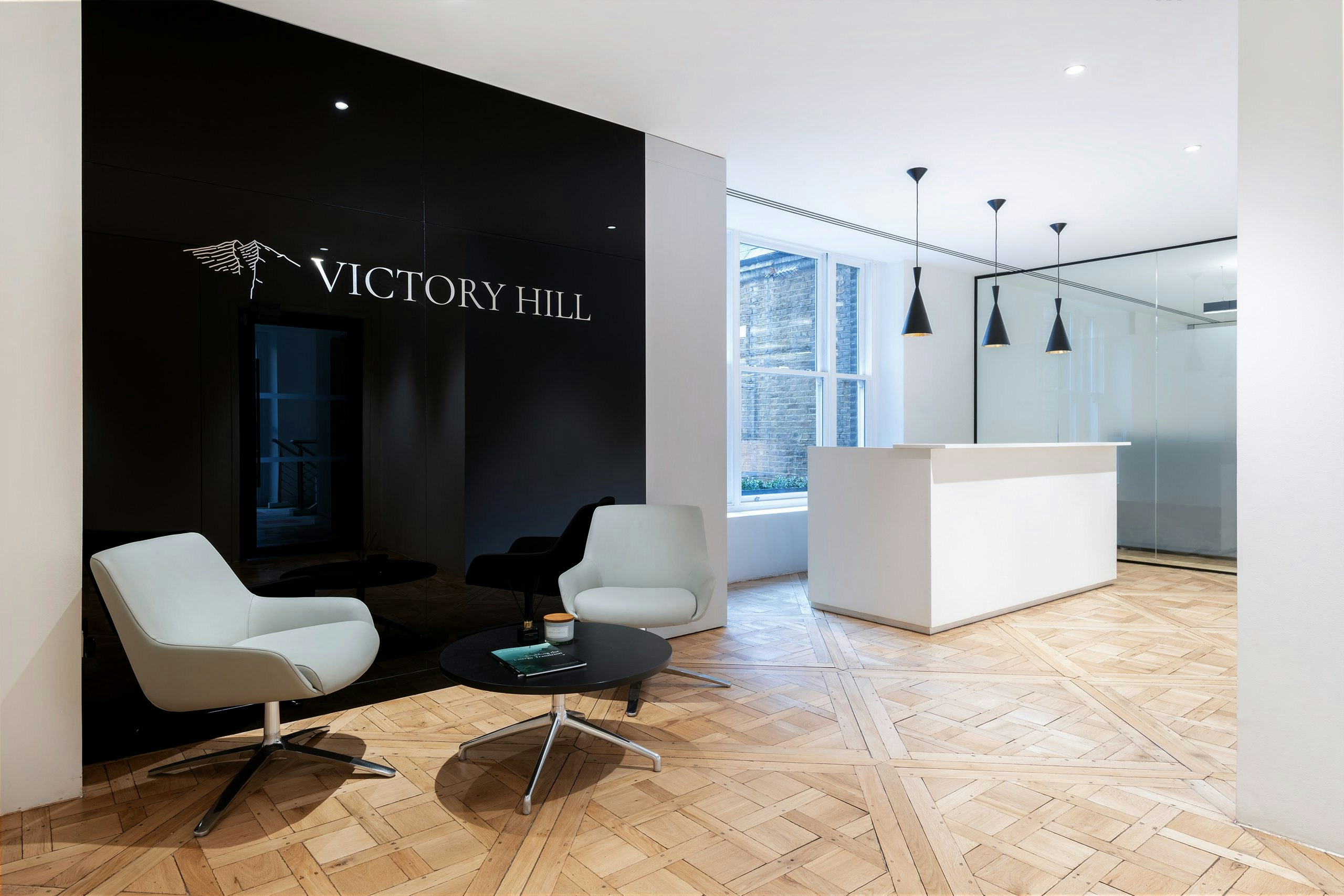
Case Study 2: Victory Hill
The Victory Hill office fit-out, located in the heart of Mayfair, is a great example of a successful office design in the financial services sector. The space is a perfect blend of historical significance and contemporary design, maintaining the building’s historical relevance while creating a modern and functional workspace for Victory Hill.One of the key design elements was the use of natural light, creating a warm and welcoming reception area that showcases Victory Hill’s brand signage with back-painted glass.
The meeting rooms are also designed to impress, featuring floor-to-ceiling glass dividers with frosted glass manifestations, ribbed soft black leather upholstered conference chairs, and dark wood conference tables, all incorporating the latest conferencing tech.The open-plan workstations have been carefully designed to maintain the aesthetic of the space while ensuring practicality with cable management and under-desk pedestals. Additionally, the lockers area has been kept to the edges and in a partition behind the print point to maintain a clean and modern look.
The Victory Hill office fit-out is a great example of how a carefully considered and well-executed office design can maintain historical relevance while creating a modern and efficient workspace. Financial service companies looking to design their new office can take inspiration from this space, with its focus on natural light, contemporary design elements, and practicality.
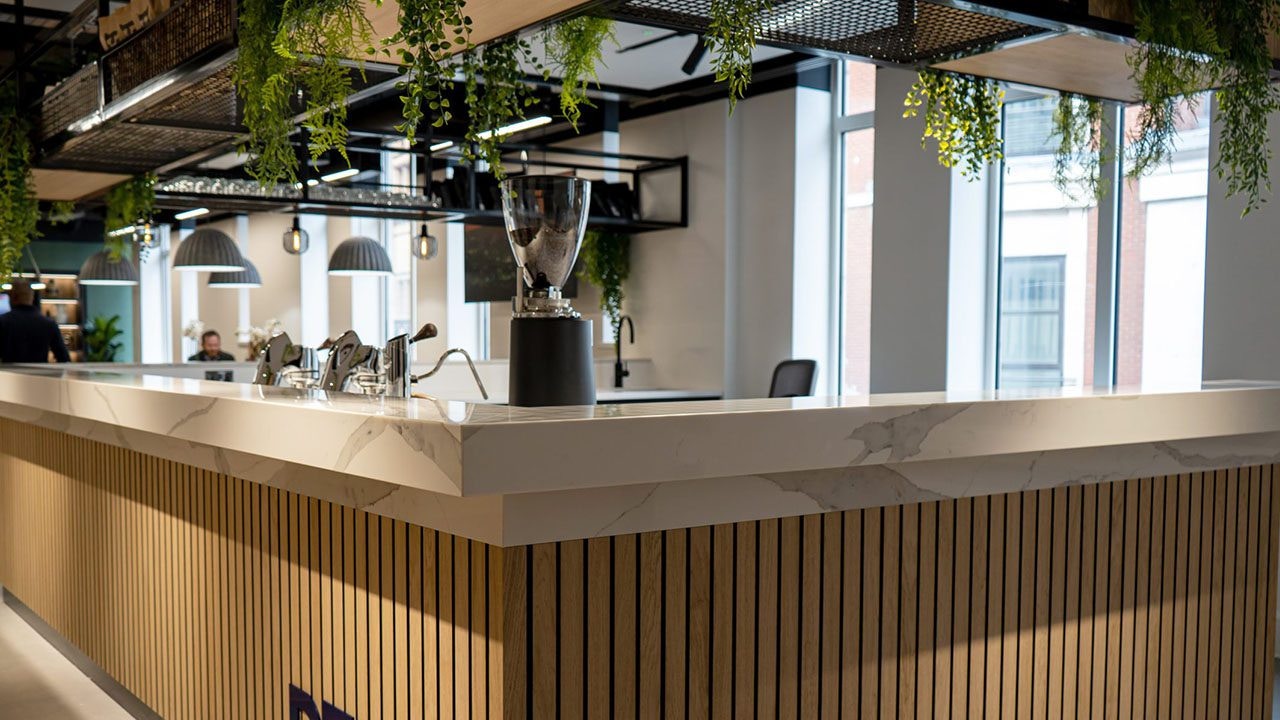
Case Study 3: DTRE
Our fit out of DTRE’s office provides valuable insights for financial service companies looking to move offices. DTRE’s approach to their fit-out project focused on creating an inspirational space for staff and visiting clients while incorporating flexibility and well-being into the design; a typical consideration in modern office fit-outs. DTRE’s focus on reducing environmental impact is also a trend worth considering, as it aligns with sustainable business practices and ESG goals.
Achieving BREEAM accreditation to the highest possible level is an excellent example of how a financial service company can demonstrate its commitment to sustainability.Another lesson from DTRE’s fit-out project is the importance of creating a space that reflects the company’s brand and culture. DTRE’s new office space was designed to be client-facing with a touch-down area for clients to grab a coffee and do their work. Companies can leverage their office space in a similar way with break-out areas that help to attract new clients and top talent.

Case Study 4: PJT
K2 Space recently completed a project for a boutique US investment firm, PJT. The project was designing their new 12,000 square-foot office space in London’s West End, and an additional 7,000 square feet to accommodate their growing team. This case study presents an excellent example of how a financial service company can benefit from a well-designed office space. The main goal of the project was to create a modern and elegant office design that would feature the highest quality materials and state-of-the-art IT infrastructure.
The design was in part used to encourage PJT’s staff to return to the office post-pandemic and promote a sense of community and collaboration.K2 Space fulfilled this brief by designing an office that features white glass-topped desks from Knoll, with dark metal frames and glazed walls to create an open and transparent feel. The new office was designed with subtle elegance in mind, using a muted colour palette and high-quality finishes throughout. The new office design also incorporated state-of-the-art IT infrastructure, with dual screens throughout the trading floor and meeting rooms to facilitate efficient communication and collaboration. The result was a modern and efficient workspace that reflected PJT’s brand identity and supported its business objectives.
The successful completion of the project was a testament to K2 Space’s expertise in designing and fitting out modern and functional workspaces. The new office has provided PJT with an environment that fosters collaboration and productivity and has helped the company to re-establish a sense of community in the post-pandemic world. For a financial service company looking to move offices and design their new office, the case of PJT fit-out provides a valuable lesson. It shows how a well-designed office space can contribute to the success of the company by fostering collaboration and productivity among employees. It also demonstrates how the use of high-quality materials and state-of-the-art IT infrastructure can create a modern and efficient workspace that reflects the company’s brand identity and supports its business objectives.
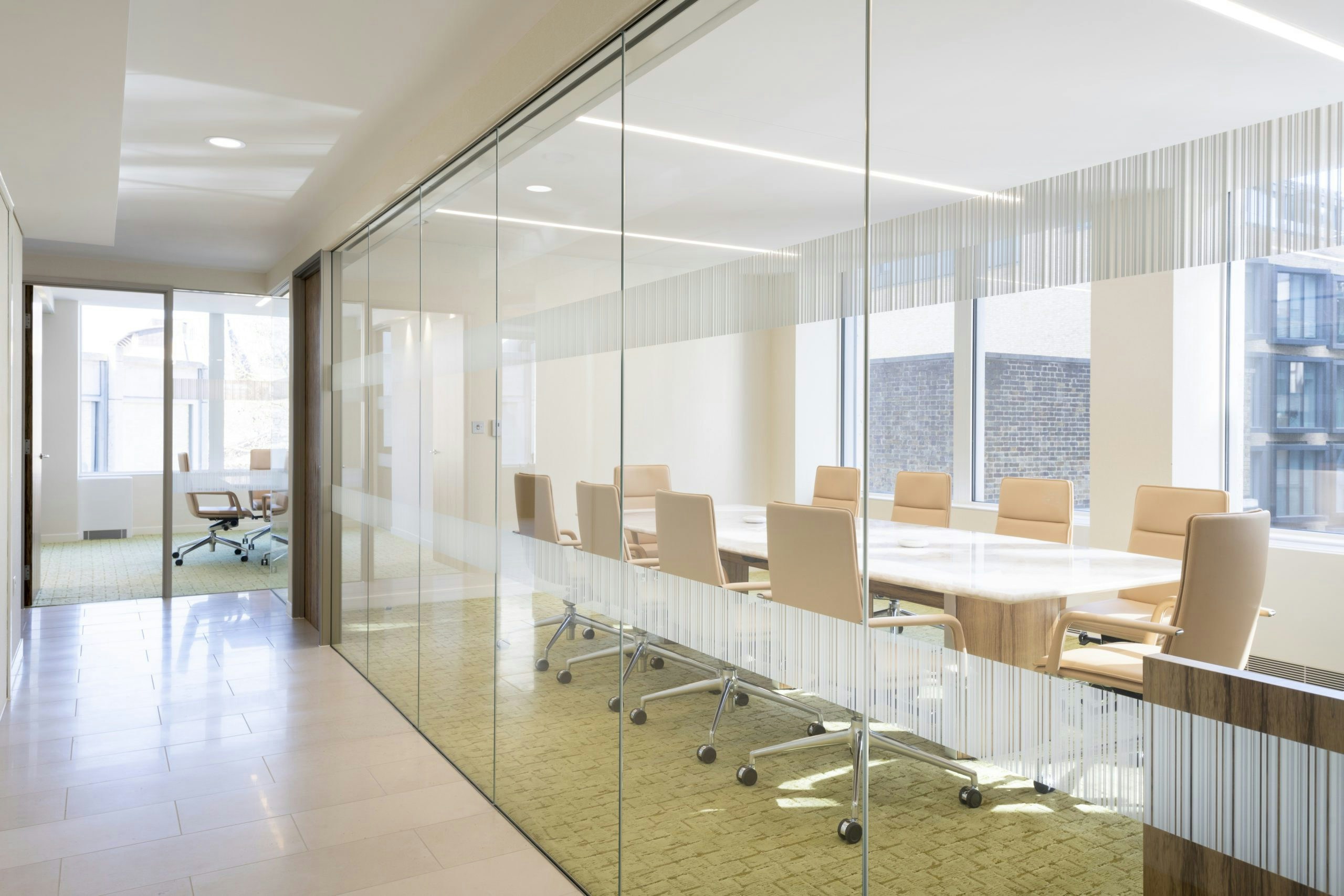
Case Study 5: LLCP
Levine Leichtman Capital Partners (LLCP), a highly successful private equity firm, needed to relocate their European headquarters to a new location that reflected its position as a market leader and could accommodate its growing investment team. LLCP approached K2 Space to design and furnish their new office on the 4th Floor of Smithson Plaza, a recently refurbished listed building on St James’s Street.
K2 Space faced a number of design implementation challenges due to the building’s listed status and legacy mechanical system. However, they worked closely with LLCP’s owners and LA team to set parameters that reflected the look, feel, and quality of the Los Angeles head office. K2 also sourced materials and products locally where possible to meet tight schedules and adhere to local building regulations and standards, while reducing the potential environmental impact of shipping and air freight.
K2 relied on their experience in supplying and installing high-end furniture and case goods, as well as their logistics and warehousing centre just outside London, to coordinate the deliveries of multiple suppliers. The team paid close attention to the small details to ensure a perfect match, such as sourcing veneers from the same tree for the workstations and office doors and flying in boardroom carpets from the US to match the LA office.
The result was an elegant and timeless office that reflected LLCP’s brand identity and satisfied their needs for functionality and comfort. The successful completion of the project was a testament to K2 Space’s expertise in designing and fitting out modern and functional workspaces.
LLCP was pleased with the outcome, and Steve Hogan, President, COO & CFO, thanked K2 Space for their outstanding work and professionalism throughout the process. Cathy, the office manager, also expressed her gratitude, saying that K2 Space shares the same work ethic, personal touch, and pride in the finished product as LLCP
Turnkey Solution for Office Design, Fit Out and Furniture Services
If you find the case studies above interesting, it would be great to hear about your project. We offer a turnkey solution for financial services companies looking to design and fit out their office space. From space planning and furniture procurement to meet on-site to discuss your ideas, right through the final design and fit-out, and completion of your new office – we do it all under one roof. Providing assistance from start to finish, our approach ensures a seamless and efficient process, with a single point of contact throughout the project.
Our expertise in the financial services sector allows us to create spaces that reflect the brand and values of the company while optimising functionality and productivity. Our extensive range of products and services also ensures that we can tailor our solutions to meet specific needs and budgets.
In creating an optimal office space for financial services, it’s important to prioritise functionality, comfort, and aesthetic appeal. Consider the needs of employees and clients, as well as the values and branding of the company. A well-designed office can improve employee satisfaction, productivity, and overall business success.
If you’re interested in discussing a new project on the horizon, it would be great to hear from you. You can reach out to our team on the details below.
Case Study 6: Global Asset Management Firm
Location: London, SW1
Size: 25,000 sq. ft.
Services Provided: Furniture Consultancy, FF&E
Challenge:
A Global Asset Management firm, and long-term client of ours, sought to expand its office space in London to accommodate its growing business needs. The challenge was to create a workspace that seamlessly blended functionality with sophisticated design, reflecting the company’s dynamic nature and commitment to excellence.
Solution:
With a focus on fostering collaboration and innovation, the expansion project emphasised the creation of social and communal areas. Sleek kitchenettes and dedicated breakout zones were introduced to encourage relaxed yet productive exchanges among employees. Meeting spaces were strategically designed to harness natural light and utilize existing building features, promoting transparency and teamwork. State-of-the-art technology was seamlessly integrated into the workspace to enhance connectivity and facilitate digital collaboration.
Outcome:
The expansion project successfully delivered a workspace that not only supports Point72’s operational excellence but also fosters employee well-being and collaboration. Through meticulous attention to detail and a commitment to blending functionality with sophisticated design, Point72 now boasts a modern and dynamic office environment that reflects its brand identity and values.
